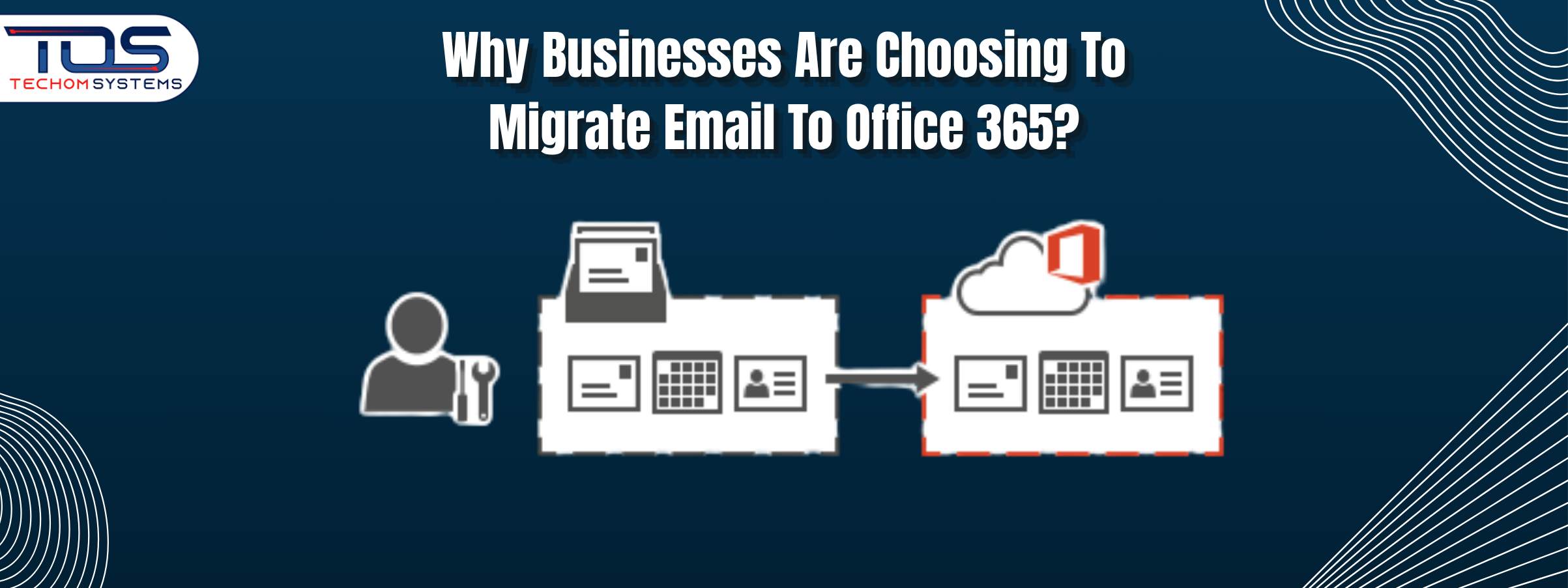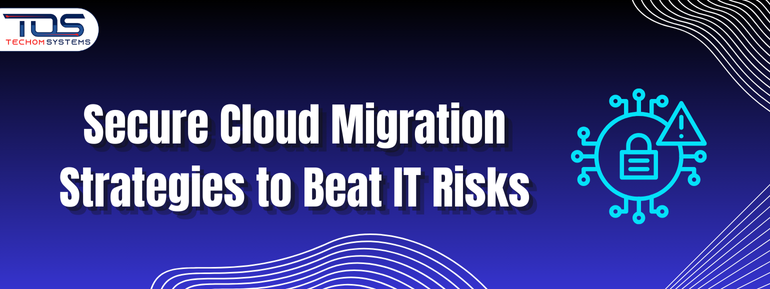Thinking about moving your apps to the cloud but not sure where to start? The migration of application to cloud is a big step for any business. It brings exciting opportunities along with important decisions.
Whether you want to improve performance, reduce IT costs or stay aligned with modern technology, this guide is here to support you. You will explore everything from what is application migration to the 7 steps of cloud migration and practical strategies that actually work.
By the end, you will have the clarity and confidence to begin your cloud journey without falling into common traps that slow others down. Let’s get started and make your move to the cloud a smart and successful one.
Need expert help for your cloud migration? Contact us today and let TECHOM Systems guide you toward a seamless and secure transition.
What is Application Migration?
As businesses grow, they often reach a point where their current software setup starts limiting their potential. Systems may slow down, costs rise and it becomes harder to keep up with market demands. That is when many companies begin exploring the migration of application to cloud for better performance, cost efficiency and flexibility.
It is the process of moving software applications from one computing environment to another. In most cases, this means shifting from on premises infrastructure to cloud platforms. It is a strategic move that helps businesses stay agile and competitive.
Benefits Of Migrating Applications To The Cloud
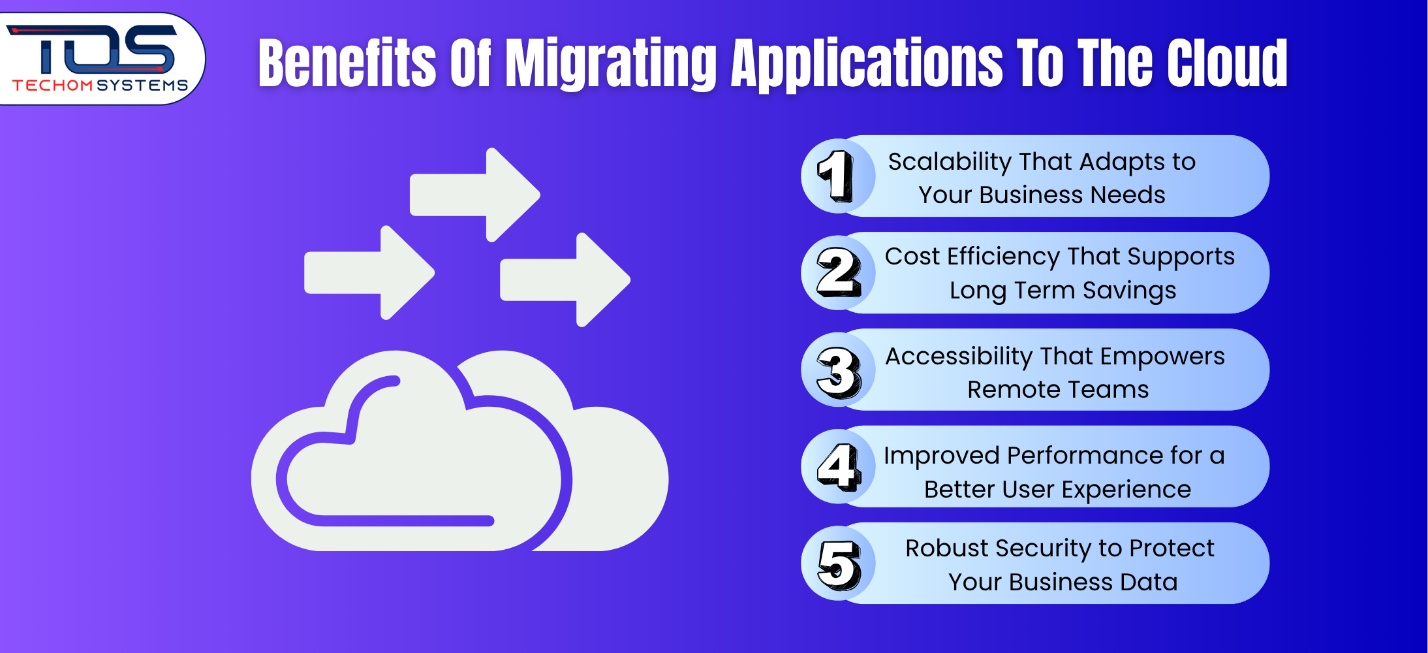
If your business is still running apps on local servers, it might be time to reconsider. Many organizations today are moving their applications to cloud platforms, not just for trend’s sake, but to meet real business goals.
From reducing costs to boosting performance, the migration of application to cloud brings a range of valuable benefits that help companies grow faster and operate smarter. Here is a closer look at how your business can benefit from application migration:
- Scalability That Adapts to Your Business Needs
As your business grows or experiences fluctuating demand, cloud environments make it easy to scale resources up or down. This flexibility means you only pay for what you use and never have to worry about outgoing your infrastructure. - Cost Efficiency That Supports Long Term Savings
Running and maintaining physical servers is expensive. By migrating your applications to the cloud, you can cut down on hardware investments, utility bills and IT maintenance costs. This shift frees up resources that can be used for innovation and growth. - Accessibility That Empowers Remote Teams
In today’s hybrid and remote work culture, having access to tools and data from anywhere is essential. Cloud hosted applications allow your team to stay productive from any location, making collaboration and communication seamless. - Improved Performance for a Better User Experience
Cloud providers offer highly optimized infrastructure that enhances the speed and responsiveness of your applications. This leads to faster load times, reduced downtime and smoother experience for your customers and internal teams. - Robust Security to Protect Your Business Data
Security is a top concern for every business. Cloud platforms offer advanced protection, including encryption, multi layered firewalls and automated updates. These features help protect sensitive information and maintain compliance with industry standards.
When you invest in the migration of application to cloud, you’re not just moving data. You’re choosing a smarter, more secure and more flexible way to operate your business.
Ready to Migrate Your Applications to the Cloud? Let our experts guide your journey. Contact us today to get a custom migration strategy built for your business goals.
Steps Of Cloud Migration
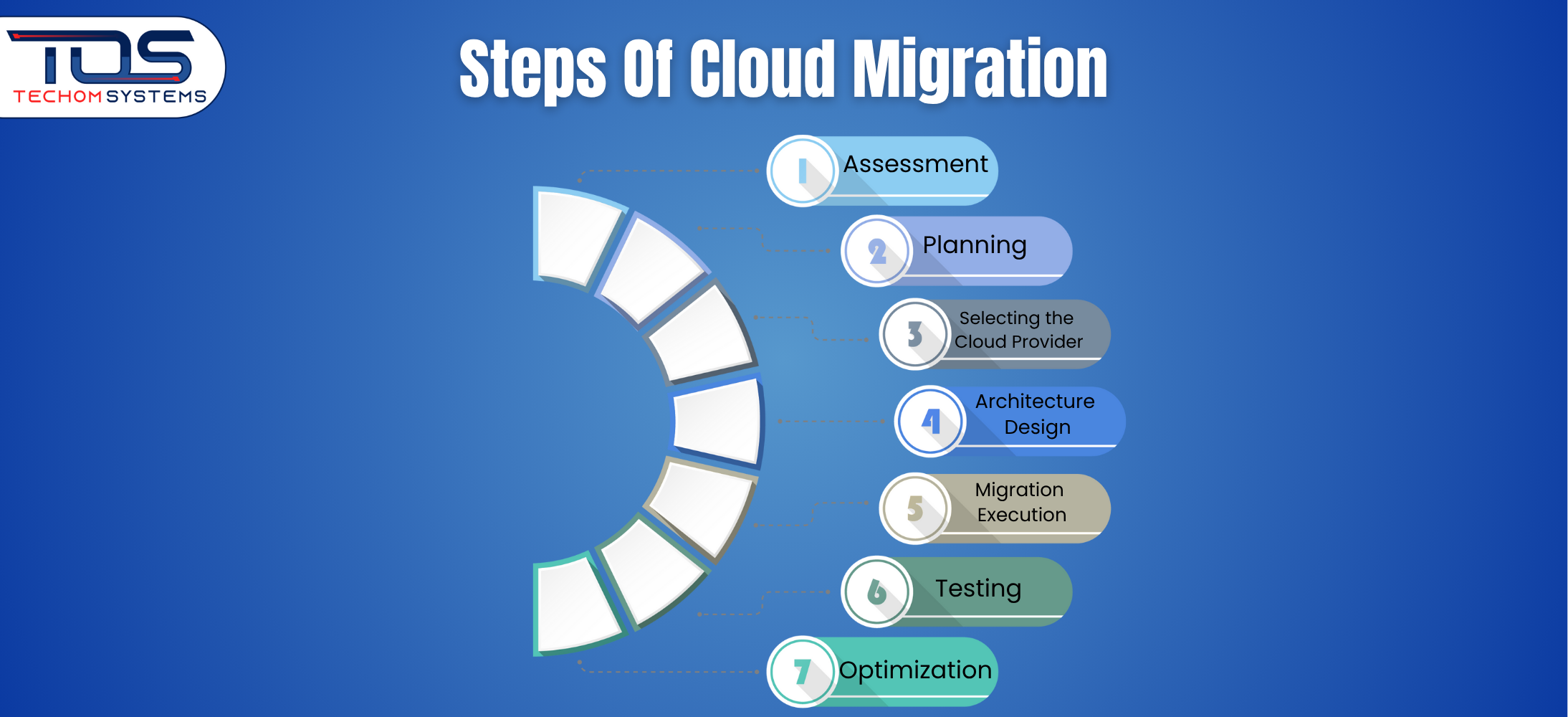
Moving your business applications to the cloud is a strategic decision that can improve scalability, reduce costs and boost performance. But the journey to the cloud is not just about technology. It requires careful planning and smart execution. Here is a step by step guide to help you in migration from application to cloud with confidence, along with practical tips to avoid common mistakes and get the most out of your investment.
1. Assessment
Before making any changes, take time to evaluate your current IT infrastructure, applications and business goals. This helps you identify which applications are suitable for cloud migration and which ones should stay on premise.
💡 Pro Tip: Create a detailed inventory of your existing systems. List down application dependencies, resource usage and any security concerns. Prioritize which apps should move first, based on business value and ease of migration.
2. Planning
A solid plan is the foundation of successful cloud migration. Define the purpose of the migration, the timeline, budget and the team responsible for each task.
💡 Pro Tip: Involve key stakeholders from both IT and business departments. Align migration goals with your business objectives. Consider setting clear milestones and KPIs to track progress and measure success.
3. Selecting the Cloud Provider
Choosing the right cloud provider is critical. Consider your business size, industry, security requirements and technical needs.
💡 Pro Tip: While choosing a cloud provider, do not go for the cheapest option blindly. At TECHOM Systems, we help you assess the right fit based on performance, uptime, security, and future scalability. Instead of jumping between random vendors, our team offers guided demos and expert advice to ensure you choose the best cloud solution for your business without the guesswork.
4. Architecture Design
Now it is time to design the cloud architecture. This includes selecting the right storage, networking, security and compute resources that your applications need in the cloud.
💡 Pro Tip: Where possible, re-architect your applications to take advantage of cloud native tools and features. This improves performance, reduces long-term management costs, and makes your systems more flexible.
5. Migration Execution
Once everything is ready, start moving your applications to the cloud based on the strategy you selected. Some apps may be lifted and shifted, while others may need to be restructured or rebuilt.
💡 Pro Tip: Begin with non-critical or low-risk applications to test the process. This allows your team to build experience and fix issues before moving high-priority systems. Document each step to make future migrations smoother.
6. Testing
After migration, test all your applications thoroughly. Make sure they are working as expected and delivering the performance your users need.
💡 Pro Tip: Perform both functional and performance testing. Involve end users to validate real-world usage scenarios. Early testing helps catch hidden issues before they become business disruptions.
7. Optimization
Once your applications are live in the cloud, the work is not over. Continue monitoring and improving your cloud environment to ensure it delivers maximum value.
💡 Pro Tip: Use built-in cloud tools to track performance, usage, and costs. Set alerts to detect unusual activity. Regularly review your resource allocation and adjust to avoid overspending or underperformance.
Hopefully, now it will become easy for you after knowing the steps to migrate applications to cloud as mentioned above.
7 Strategies For Migrating Applications To The Cloud
When it comes to cloud adoption, every business has different needs and technical environments. Choosing the right and secure cloud migration strategies is crucial to avoid downtime, unnecessary costs or compatibility issues. Whether you are planning to move a few apps or your entire infrastructure, these strategies will help you build a solid migration plan that suits your goals. Here are the 7 strategies for migrating applications to the cloud:
1. Rehosting (Lift and Shift)
This is the simplest approach where you move applications to the cloud without changing anything. It works well for businesses that need a quick transition and want to minimize upfront changes. Think of it as moving your current system from one location to another.
2. Replatforming
In this strategy, you make a few adjustments to optimize applications for the cloud. These changes do not alter the core architecture but help improve performance. It is ideal for companies that want better results with minimal effort.
3. Repurchasing
This involves replacing the existing application with a cloud based version, usually a Software as a Service (SaaS) product. It is perfect for outdated or expensive software that no longer meets your needs.
4. Refactoring
Here, you architect the entire application to take full advantage of cloud native features. This is a long term strategy that delivers great performance, flexibility and cost savings. It is best for companies that are serious about innovation and scalability.
5. Retiring
During the assessment phase, you might find some applications are no longer useful. This strategy helps identify those and remove them from your system, saving costs and reducing maintenance efforts.
6. Retaining
Not all applications are ready for the cloud. Some may be tightly integrated with legacy systems or subject to strict regulations. In such cases, keeping them, on premises is a valid option until you are fully ready to migrate.
7. Relocating
Relocating means shifting applications to another physical data center or location without changing the application itself. This is suitable when your organization is moving its entire IT setup or consolidating operations.
Need help deciding the best strategy? At TECHOM Systems, we guide you through every step of cloud migration, right from planning to execution. Reach out today and let’s build a strategy tailored to your business.
Phases Of Migrating an Application To The Cloud
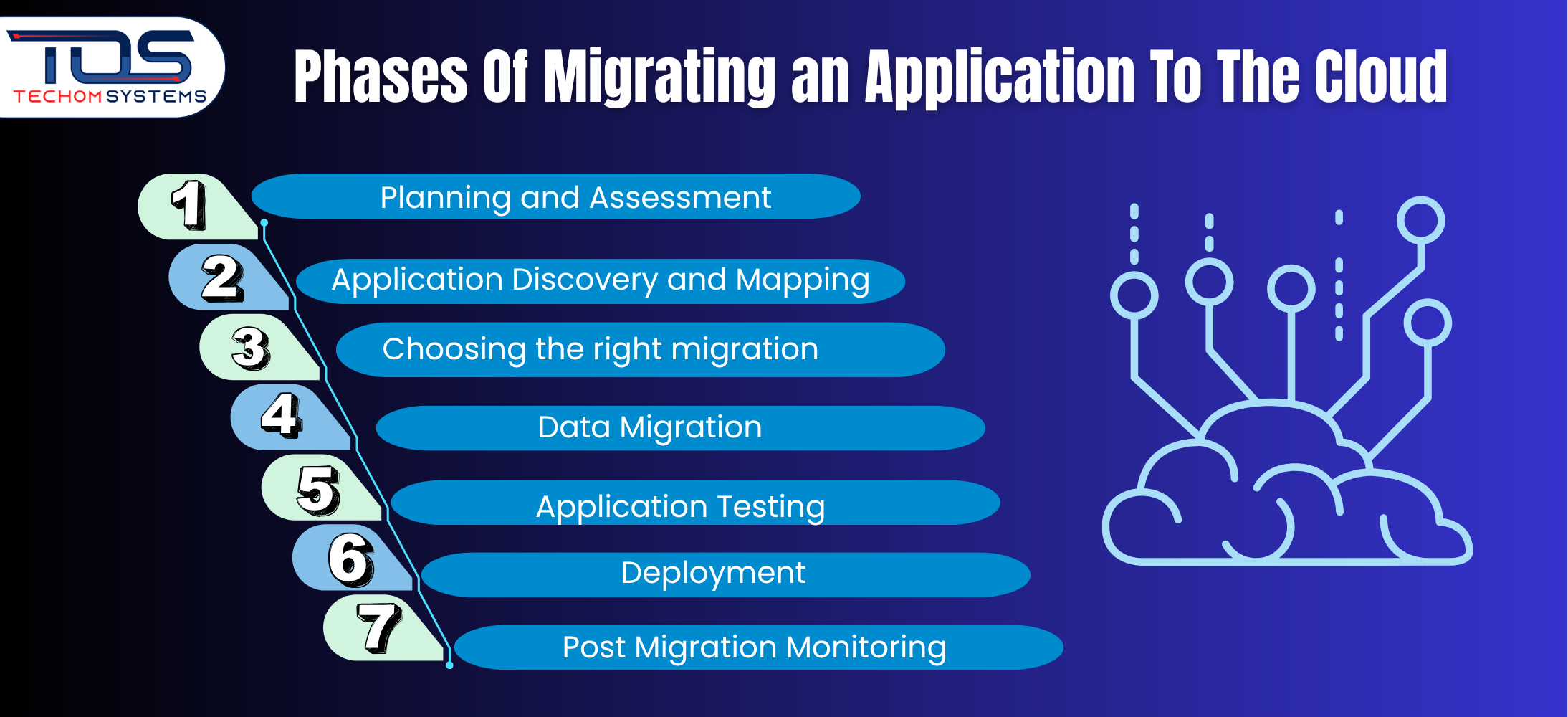
Moving to the cloud can feel like a big leap, especially when your business relies on multiple applications for day to day operations. To make this transition smooth and effective, it is important to understand the core phases of migrating an application to the cloud. Following a structured process reduces risks, prevents downtime and ensures your applications perform better in the new environment. Here are the key phases of migrating an application to the cloud:
1. Planning and Assessment
This is the foundation of the migration journey. During this phase, your team identifies which applications are ready to move, what dependencies exist and what success will look like. A detailed evaluation of your existing infrastructure helps avoid surprises later.
2. Application Discovery and Mapping
Once you know which applications are moving, it is time to understand how they connect and operate. Mapping dependencies, data flows and configurations ensures that no critical element is left behind during the move.
3. Choosing the Right Migration Strategy
There are many ways to move to the cloud, such as rehosting, replatforming or refactoring. In this phase, you select the best strategy for each application based on its complexity, performance requirements and long term goals.
4. Data Migration
This is when actual data is transferred from on premises systems to the cloud. It is important to do this securely and with minimal disruption. Proper backups and checks are essential during this step.
5. Application Testing
After the data and applications are moved, testing is critical. You need to confirm that everything works as expected in the new environment. This includes functionality, performance and integration with other services.
6. Deployment
With successful testing completed, your application goes live in the cloud environment. This stage also includes final setup tasks like configuring load balancers, setting permissions and preparing your team for usage.
7. Post Migration Monitoring and Optimization
Even after going live, the work is not done. Continuous monitoring ensures that the application is secure, stable and running efficiently. You can also optimize performance and cost at this stage by using built in tools from your cloud provider.
Challenges In Cloud Application Migration
Migrating applications to the cloud brings many benefits, but it also comes with challenges that can impact performance, security and cost if not handled properly. Below is a table outlining the most common challenges in cloud application migration along with practical tips on how to avoid them:
| Challenge | Explanation | How to Avoid It |
| Downtime | Migration can cause temporary interruptions that affect users and productivity. | Plan the migration during low traffic hours, use backup systems and test ahead. |
| Data Security | Data may be exposed or lost during the move if not properly secured. | Use strong encryption, access control and back up all sensitive data before moving. |
| Compatibility | Some applications may not run the same in a cloud environment. | Test applications in a staging cloud environment and refactor if needed. |
| Cost Management | Without tracking, cloud costs can quickly increase beyond the expected budget. | Set up cost monitoring tools, define budgets and review resource usage regularly. |
| Skill Gaps | Your team may not have the expertise needed to handle cloud platforms. | Upskill internal staff or bring in a trusted cloud partner like TECHOM Systems. |
Cloud Application Migration Checklist
Cloud application migration can bring scalability, cost savings and improved efficiency. But without proper planning, it may lead to delays, security concerns or performance issues. This checklist will help you prepare for a smooth and successful migration. Here is a clear and actionable cloud application migration checklist for your cloud migration journey:
1. Define business goals and outcomes
Understand why your organization is moving to the cloud. Set clear goals such as cost reduction, improved agility or better system availability to measure success.
2. Perform a detailed assessment of current infrastructure
Review your existing infrastructure. Identify applications that are cloud ready and those that need modifications before migration.
3. Choose a reliable cloud provider
Select a provider that aligns with your business needs. Consider their security policies, compliance standards, support options and cost structures.
4. Select the appropriate migration strategy
Pick a strategy that fits your goals and the complexity of your applications. Common strategies include lift and shift, replatforming and refactoring.
5. Backup all data before migration
Create secure backups of all critical data. This ensures you can restore operations quickly if anything goes wrong during migration.
6. Test applications post migration
Test your applications in the new environment. Ensure they run smoothly, integrate well with other systems and meet performance benchmarks.
7. Monitor performance and optimize regularly
After deployment, keep monitoring your cloud applications. Use insights to optimize performance, control costs and improve user experience over time.
Choose TECHOM Systems For Cloud Migration Consulting Services
Choosing the right partner for your cloud migration journey can make all the difference. At TECHOM Systems, we offer more than just technical expertise. We deliver strategic, secure and smooth migration experiences tailored to your business goals. What we offer in our cloud migration consulting services just sets us apart:
- Strategic Guidance for Business Growth
Our cloud migration services include expert consultation to align your cloud strategy with business objectives. We help you gain flexibility, scalability and long term value through smart planning. - Smooth and Secure Cloud Transitions
We ensure every stage of your migration process is seamless and secure. Our experts handle the transition with care, ensuring data integrity and minimal disruption to your operations. - Innovation Driven Transformation
With our cloud first strategy, we do more than migrate. We help transform your business. From boosting customer experiences to enabling operational efficiency, we focus on real results. - Trusted Cloud Migration Services in Australia
TECHOM Systems is a reliable choice for cloud migration services in Australia. We deliver smooth transitions so your team can stay productive and focused during the process. - Smart Cost Optimization
Make the most of your IT budget. With the cloud’s pay as you go model, we help you eliminate unnecessary expenses and use resources efficiently. - Security and Compliance You Can Trust
Your data’s safety is our top priority. We ensure your cloud environment meets all regulatory standards and follows best practices for security.
Ready To Transform Your IT Infrastructure With Expert Cloud Migration Services?
Contact TECHOM Systems today to schedule your free consultation.
Frequently Asked Questions (FAQs)
#1: What Is The Process Of Migrating Application To Cloud?
The process involves assessing current systems, choosing the right cloud model, planning, selecting a migration strategy, executing the move, testing performance and optimizing the setup.
#2: What Are The 7 Strategies For Migrating Applications To The Cloud?
The seven strategies are: Rehost, Replatform, Repurchase, Refactor, Retire, Retain and Relocate. Each offers a different level of cloud integration depending on your business needs.
#3: How Do I Move An Application To The Cloud?
Start by analyzing the app’s architecture, choose a cloud provider, select a migration strategy, move data securely, test everything and go live with full monitoring.
#4: What Are The 7 Steps Of Cloud Migration?
The 7 steps include: assessment, strategy planning, choosing tools, migrating data, app migration, testing and optimization. A smooth migration of application to cloud depends on each step being done right.
#5: Need Help With Cloud Migration For Your Business?
Contact TECHOM Systems today for expert guidance and a custom migration strategy tailored to your business goals.
Conclusion
Migrating applications to the cloud is no longer just a trend, it is a smart move for businesses that want to stay competitive, improve performance and reduce costs. In this blog, we discussed the full process of migration of application to cloud, from identifying key challenges to following a structured 7 step approach. We also shared a detailed migration checklist to help you avoid common mistakes and stay prepared throughout the journey.
Wondering How To Get Started With The Migration Of Application To Cloud For Your Business?
Contact TECHOM Systems today and let our experts help you plan and execute a smooth, secure and cost effective transition.

A results-driven content strategist and IT writer with over 7 years of experience simplifying complex tech concepts into clear, actionable insights. Specialising in cloud computing, cybersecurity, and enterprise IT trends, he crafts content that bridges the gap between technical depth and business value.




